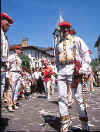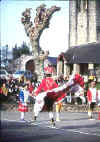Dancing Across
the Atlantic: dance groups and performances in the U.S. and in the Basque Country
by Lisa Corcostegui
Although we do many of the same
Basque folk dances in the United States that are performed in the
Basque Country, there are some differences in the organization of
dance groups and performances. This article will
explore some of these.
Basque Dance in the U.S.
In the United States almost all
Basque dance groups are sponsored by or affiliated with a Basque
club that belongs to North American Basque Organizations,
Inc. (NABO).
Proportionally, more Basque-Americans participate in dance than
their European counterparts. Most Basque-Americans who
live in locations with Basque clubs have danced at some point in
their lives and dancing serves as a kind of rite of passage into
Basque identity for children; apart from family or group
identity dancing gives a child a personal feeling of being
Basque. Children's dance groups lend a sense of vitality to
a club and are the first step in transmitting cultural
heritage.
Dance groups usually have a mixed
repertoire of dances from several parts of the Basque Country,
although some groups with a majority of members from some single
location in the homeland focus more on dances from their area. In
addition to dance practices held by each local club, NABO hosts a
summer culture camp called Udaleku
where dancers from different clubs come together to learn dance,
music, culture, and form friendships with children from other
places.
Basque-American dance groups
perform at events organized by their clubs such as picnics,
festivals and potlucks. These events provide a venue for the
dancers to show family members what they have learned at dance
practices much like a recital.
Most dance groups also perform
locally for outside organizations such as service clubs and
conventions. In this type of performance the dancers
represent Basque heritage to a wide variety of spectators who may
or not be familiar with the Basques. This type of
performance requires more verbal interaction with the audience in
terms of providing a broad description of who the Basques
are, where they come from, and the context of the dances offered.
Many Basque clubs host the
performance of groups from other clubs at their festivals. Many
dancers say this is their favorite kind of performance. Of course,
this kind of performance requires travel to the location of the
hosting club. Since Basque clubs are located all across the west,
the distances can be quite long. The travel time, however,
is usually fun and a lot of group bonding happens this way.
The actual performance is usually limited to around 20
minutes. A significant difference in this kind of
performance is that the audience often includes dancers from other
groups. There is usually little or no coordination of
programs between groups and each one presents whatever it wants
to. This results in a lot of repetition of the same dances
throughout the day. This repetition has had an unfortunate
effect on dance in the U.S. in that traditional dances have been
altered to make them look different than the way the next group
does them. This is unfortunate because with each change
(even though we may consider it small) we risk destroying part of
the original metaphor that underlies the dance. This topic
of authenticity versus originality can be controversial, of
course. I don't intend to enter into that kind of argument
here. However, it is something I think Basque-American
dancers should be keenly aware of - after all, don't most of us
say that we dance to "preserve" our Basque heritage?
The last type of performance I will
mention in the context of Basque-American dance is the most
rare here. This is ritual dance performed on a specific
occasion. A well-established example of this type of dance
can be seen in Boise, Idaho during the celebration of the feast of
Saint Ignatius of Loyola. The dances are borrowed from the
celebration of Corpus Christi in Oņati, Gipuzkoa. In their
original context they celebrate the Blessed Sacrament; in the
American version they are performed in honor of San Inazio, the
patron saint of the Basques. Despite this change, this cycle
of dances closely follows the pattern of ritual dance present
throughout the Basque Country for a wide variety of feast
days. The
Boise San Inazio celebration includes a procession with the
image of the saint and dances outside and inside the cathedral
including a dance on the altar.
Dance in the Basque Country
In contrast to the types of dance performance we typically see
in the States, the real richness of Basque dance is found in
unique local traditions. Many towns and villages in the
Basque Country celebrate the festival of their patron saint or
other occasions such as carnival with completely unique
dances. The celebration of Corpus Christi in Oņati was just
mentioned above. Other examples include the dances of Lesaka
celebrated in honor of San Fermin, Azeri Dantza performed on San
Juan in Andoain, the Kaxarranka and Eguzki Dantza on San Pedro y
San Pablo in Lekeitio, Sagar Dantza in Arizkun for Carnival,
Bolant Eguna in Luzaide on Easter, and the Maskarada of Zuberoa
for Carnival. The participants in the ritual dances are usually
adults although there is sometimes a group of children who perform
the dances at other events. These traditions involve the
entire population in celebration and provide a sense of identity
and pride to a town's citizens.
Another type of dance group found
in the Basque Country is that which originally arose from local
church parishes as a youth activity. Similar kinds of groups
are associated with clubs that foment the use of Basque language
and other activities such as mountain climbing. In addition
dance groups are sometimes sponsored by the municipality. These
types of groups are sometimes referred to as "urban"
groups. Although these groups may be found in locations that we
may not necessarily think of as being urban, the designation
contrasts with the village groups described above that have their
own unique traditions. These urban groups perform a variety
of dances from all over the Basque Country, often in sets of
dances from a specific location with costumes from there as
well. These groups encompass a greater age range than the
ritual groups and are more like their American
counterparts. Besides performing at local celebrations
dance groups sometimes perform outside of the Basque Country and
have other responsibilities in their respective towns such as
dancing Agurra at events such as weddings or civic ceremonies or
organizing other aspects of festivities such as parading giants
through town.
The organization that offers
resources to dance groups in the Basque Country is called Euskal
Dantzarien Biltzarra (EDB). This federation of dance
groups organizes workshops, contests, and performances for its
member groups. Towns take turn hosting events called
Dantzari Eguna (Dancers' day) or Haurren Eguna (children's day)
which are organized regionally.
This is how an Haurren Eguna I
attended unfolded: Early in the day groups from the region arrive
and congregate in a central location where they are offered a
snack and get organized for their performance. They are
accompanied by dancers from the older dance group who help
supervise them and manage their equipment. All groups then
parade through the streets stopping at intervals to perform one or
two dances. All groups end up in the plaza where they
perform a series of dances. Each group is assigned a certain
zone of the plaza and all groups perform the same dances
simultaneously. Each group at some point also performs a
dance by itself. If the group is from a town that has its
own unique tradition this dance may be presented at this
time. At lunch each guest dancer is hosted by a local family
and eats at their home. These are usually the families of
local dancers. At the Haurren Eguna I attended in Azkoitia
the instructors and chaperones were treated to lunch at a local
gastronomical society. After lunch the groups reconvene in
the plaza for more dancing.
Popular Dance Movements in the
Basque Country
In recent years there has been a resurgence of interest in
Basque dance by people who do not belong to dance groups.
The Kafe Antzokia in Bilbo hosts a monthly dance called Dantza
Ganbara led by Juan Antonio Urbeltz. The event is very well
attended by people of different age groups. Urbeltz explains
the dances, gives instructions and guides dancers as his wife
Marian Arregi and son Mikel play beautiful renditions of
traditional dance pieces. A couple of dancers from Argia dance in
the center and assist participants. Other dance groups offer
opportunities for the general public to learn traditional dances
as well. Elgoibarko Haritz, Debako Gure Kai eta Eibarko
Kezka started a series of dance events called Plazara
Dantzara and Patxi eta Batbiru puts on public dance sessions
and has produced a terrific music
CD complete with video instruction.
Bridging the Gap
Over the last decade there has been increasing contact between
dance groups in the U.S. and the Basque Country. Basque
Americans now have more opportunities than ever to learn more
about their heritage and introduce more authenticity into their
dance programs. For many years NABO has offered a series of
dance videos filmed in the Basque Country by John and Jenny Ysursa.
For more information contact John.
Finally, some exciting news about a
program offered to dancers and instructors. This year the Basque
Government's Gaztemundu Program will focus on dance. For
this year only there will be no age restrictions.
Participants will visit dance events in the Basque Country and
learn more about dance.
More
information about Gaztemundu 2002
|
Click
images to view larger version

Utahko Triskalariak in Mountain
Home, Idaho

Beti Alai of Ontario, Oregon at
Malheur County Fair

Boise's Oinkari Dancers in
Winnemucca, Nevada

Oņati Dancers of Boise Idaho on Feast
of Saint Ignatius of Loyola

Korpus Eguna in Oņati, Gipuzkoa

Bolantak in Luzaide, Nafarroa

Maskaradak in Gotaine, Zuberoa

Kaxarranka in Lekeitio, Bizkaia

Eguzki Dantza in Lekeitio, Bizkaia

Haurren Eguna in Azkoitia,
Gipuzkoa

Haurren Eguna in Mutriku, Gipuzkoa

Dantza Ganbara at Kafe Antzokia in
Bilbo
|